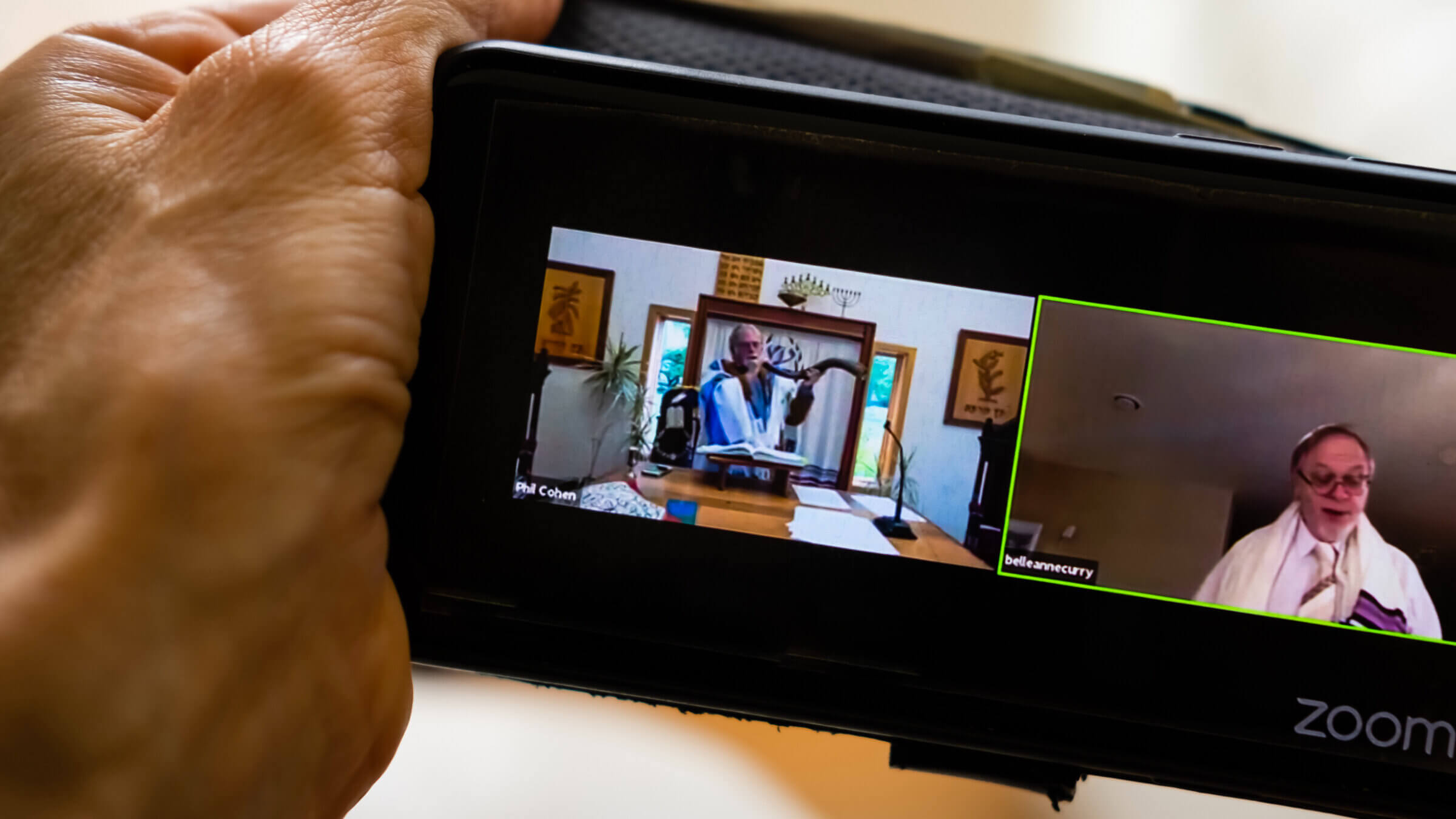Why go to one synagogue service when you can go to many? Congregants confess their love of virtual shul hopping
Now Jews can daven across time zones and denominations, checking out services at multiple congregations over the course of a few hours

A woman streams a Rosh Hashanah service on September 19, 2020 in Columbia, Missouri. Photo by Lana2011
 This Rosh Hashanah, Chuck Levine of Fort Lauderdale began watching services online at Park Avenue Synagogue, a Conservative shul in Manhattan, where he finds both the rabbi and cantor “engrossing.”
This Rosh Hashanah, Chuck Levine of Fort Lauderdale began watching services online at Park Avenue Synagogue, a Conservative shul in Manhattan, where he finds both the rabbi and cantor “engrossing.”
Then he switched to Temple Emanu-El, which is Reform, and also in New York, because it was once his spiritual home and he and his non-Jewish spouse always felt comfortable there.
Then he checked out Temple Keneseth Israel, a Reform congregation in Allentown, Pennsylvania, that he used to attend when he lived there.
“The rabbi I knew retired and they have a new rabbi who I wanted to hear speak,” Levine, 76, explained.
When COVID-19 turned synagogue sanctuaries into television studios, with cameras, lighting and tech crews, it also gave congregants nearly endless choices. Now Jews can daven across time zones and denominations, checking out services at multiple congregations over the course of a few hours.
Pray Shacharit in St. Louis and Ma’ariv in Minneapolis. Zoom with your congregation and then tap into the livestream from the one you used to belong to. One man in Georgia said he surfs through an average of a dozen synagogues each Shabbat.
Call it shul hopping, or maybe shul surfing.
Many of those who shul surf say they are still not attending services in person for fear of catching COVID-19. Others just like to avoid the hassle of dressing up and leaving the house. Then there are those who simply appreciate the opportunity to sample. They can personalize a schedule of virtual shul visits that satisfies a multiplicity of desires, among them, listening to a particularly inspiring rabbi, and discovering how another congregation approaches a particular prayer.
“I generally do three synagogues on Shabbat online,” said Susan Levine, 66, of Sonoma, California. Her all-California mix draws from both the Reconstructionist and Renewal movements: Congregation Ner Shalom in Cotati, Congregation Shir Shalom in Sonoma, and Or Zarua, in Berkeley.
For Levine, who uses a wheelchair, it’s simply “easier” to participate in services from home, though she went in person to Shir Shalom on Erev Rosh Hashanah this year, her first time in shul since the pandemic began.
Alan Berg, a Southerner, emailed the Forward about his elderly parents, who are avid shul surfers.
“They hop around from New York to Chicago to Houston to Los Angeles,” wrote Berg. “They enjoy “listening to rabbis of different persuasions and cantors with different styles.”
They also appreciate not having to dress up, and the being able to get a cup of coffee in their own kitchen during services, he added.
Rabbis know that Jews do this.
Take Rabbi Ashira Konigsburg, chief program officer of the United Synagogue of Conservative Judaism. Her parents, like Berg’s, tune into several different synagogues for services.
Konigsburg said it’s a good thing that people can “shul hop and see the talents of rabbis and cantors across the country.” But she also cautioned that dropping into a Zoom or livestream doesn’t afford the advantages of being part of a Jewish community.
“It’s unlikely the rabbi you are watching in Chicago will be able to come to New Jersey to officiate at your mom’s funeral,” she said.
For some congregants, shul surfing made sense during the height of the pandemic, but not after infection rates subsided and they felt comfortable returning to their own congregations.
Fran Goldman of Delray Beach, Florida, is a loyal member of Temple Anshei Shalom. But when COVID-19 hit in 2020, she isolated in her home and began attending “many shuls” virtually, including Park Avenue Synagogue in Manhattan; Temple Emanuel, a Conservative synagogue in Newton, Massachusetts; Sinai Temple in Los Angeles; and Central Synagogue in Manhattan.
“I wanted to see what they were doing,” she explained. “I would do a Reform shul like Central Synagogue on Friday night and a Conservative on Saturday.”
The Forward is free to read, but it isn’t free to produce

I hope you appreciated this article. Before you go, I’d like to ask you to please support the Forward.
Now more than ever, American Jews need independent news they can trust, with reporting driven by truth, not ideology. We serve you, not any ideological agenda.
At a time when other newsrooms are closing or cutting back, the Forward has removed its paywall and invested additional resources to report on the ground from Israel and around the U.S. on the impact of the war, rising antisemitism and polarized discourse.
This is a great time to support independent Jewish journalism you rely on. Make a gift today!
— Rachel Fishman Feddersen, Publisher and CEO
Support our mission to tell the Jewish story fully and fairly.
Most Popular
- 1

Culture Cardinals are Catholic, not Jewish — so why do they all wear yarmulkes?
- 2

Fast Forward Ye debuts ‘Heil Hitler’ music video that includes a sample of a Hitler speech
- 3

News School Israel trip turns ‘terrifying’ for LA students attacked by Israeli teens
- 4

Fast Forward Student suspended for ‘F— the Jews’ video defends himself on antisemitic podcast
In Case You Missed It
-

Yiddish קאָנצערט לכּבֿוד דעם ייִדישן שרײַבער און רעדאַקטאָר באָריס סאַנדלערConcert honoring Yiddish writer and editor Boris Sandler
דער בעל־שׂימחה האָט יאָרן לאַנג געדינט ווי דער רעדאַקטאָר פֿונעם ייִדישן פֿאָרווערטס.
-

Fast Forward Trump’s new pick for surgeon general blames the Nazis for pesticides on our food
-

Fast Forward Jewish feud over Trump escalates with open letter in The New York Times
-

Fast Forward First American pope, Leo XIV, studied under a leader in Jewish-Catholic relations
-
Shop the Forward Store
100% of profits support our journalism
Republish This Story
Please read before republishing
We’re happy to make this story available to republish for free, unless it originated with JTA, Haaretz or another publication (as indicated on the article) and as long as you follow our guidelines.
You must comply with the following:
- Credit the Forward
- Retain our pixel
- Preserve our canonical link in Google search
- Add a noindex tag in Google search
See our full guidelines for more information, and this guide for detail about canonical URLs.
To republish, copy the HTML by clicking on the yellow button to the right; it includes our tracking pixel, all paragraph styles and hyperlinks, the author byline and credit to the Forward. It does not include images; to avoid copyright violations, you must add them manually, following our guidelines. Please email us at [email protected], subject line “republish,” with any questions or to let us know what stories you’re picking up.
















